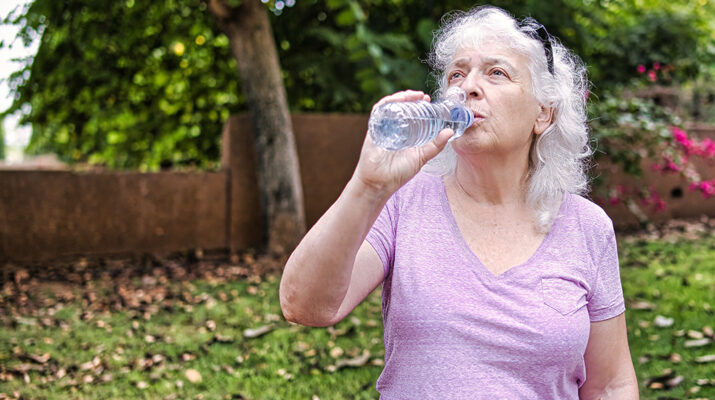Many caretakers of older adults struggle to get them to drink enough fluids
By Deborah Jeanne Sergeant
Up to 40% of adults older than 65 are chronically dehydrated, according to a study noted by Sage Journals in 2019.
This can lead to a plethora of problems for those receiving support for activities of daily living, whether in a long-term care facility or home care.
Insufficient hydration and their cognitive and physical struggles both worsen with dehydration and contribute to dehydration.
“Dehydration is a very common issue we see in older adults, particularly in people with cognitive impairment,” said Ahmed Rab, lead physician at Rochester Regional Health’s Unity Geriatric Associates. He noted that dehydration contributes to issues with the kidneys, liver and other organs. It also can cause or worsen constipation and lower immune function.
Many older adults skimp on drinking water because they fear falling if they need to rush to the bathroom. However, not drinking enough can cause dizziness or lightheadedness.
“It’s caused by orthostatic hypertension, when you change position from sitting to standing or sitting up from lying down,” Rab said. “They have a drop in blood pressure because there’s not enough time for blood to get back to the brain. It can increase falls.”
One way it contributes to falls is that dehydration can cause orthostatic hypertension, a sensation of dizziness upon rising. Lack of hydration also can cause confusion and disorientation, which can cause falls or other injuries.
In addition to purposefully drinking less water, older adults can be at higher risk of dehydration because the sensation of thirst dulls with age.
“They can be dehydrated without knowing it,” Rab said. “There’s also a lot of health conditions in older adults like chronic kidney disease which can increase dehydration. Or they may take diuretics.”
One sign that a person needs more fluids is dark urine and little urination. Also look for signs of dry mouth, fatigue and headache. People who frequently experience urinary tract infections may also be chronically underhydrated.
Encouraging greater fluid intake can be tricky.
“It’s perfectly common for people to say, ‘I’m not thirsty, so why should I drink?’” said Sarah Cook, registered dietitian for UR Endocrinology at Highland Hospital.
She wants caregivers to encourage those in their care to drink before they feel thirsty. Sipping water, milk or 100% juice between bites can help get more fluids in during meals. Offering a variety of fluids can make it more interesting, as well as adding a splash of juice or cut up produce to water. Citrus slices, berries or cucumbers pieces in a pitcher of water infuses it with flavor.
For people who enjoy carbonated beverages, sparkling water provides a similar effect but without calories or added sugar. Coffee and tea are fine as well, but drinking these all day can have a diuretic effect unless they’re caffeine-free varieties.
“I encourage people to think of food-based fluid sources,” Cook said.
Broth-based soup, sugar-free gelatin, popsicles, yogurt and cottage cheese are all high in liquids. Cook noted that high water content produce includes watermelon, cucumbers, strawberries, celery, orange, tomatoes and many others.
Try habit stacking to get more fluids in, such as a glass of water upon rising and when taking a pill.
“If you’re about to go for a walk or leave the house, have a glass of water or bring a bottle of water with you,” Cook said. “If you are hanging out at home, sometimes visual triggers like a colorful cup near the sink or fridge helps so whenever you’re walking through the kitchen, you’ll have a quick cup of water and move on.”
Offering ice-cold water may help. Those prone to feeling chilly may favor a warm beverage. A double wall insulated tumbler with a secure lid can make it easier to keep a drink handy without risking spills.

